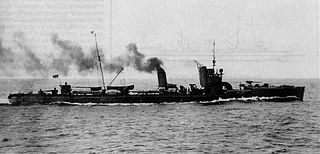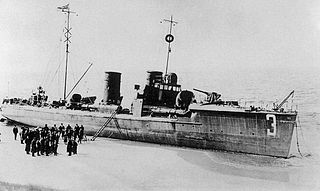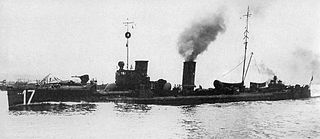SMS V48 was a 1913 Type Large Torpedo Boat of the Imperial German Navy during World War I, and the 24th ship of her class.

The B 97 class was a class of eight destroyers built for and operated by the Imperial German Navy during the First World War. They served throughout the war, with one being lost in 1915, five being scuttled at Scapa Flow in 1919 and one being transferred to Italy, where it remained in use until 1939.
SMS V27 was a V25-class torpedo boat of the Imperial German Navy that served during the First World War. The ship was built by AG Vulcan at Stettin in Prussia, and was completed in September 1914. The ship was sunk at the Battle of Jutland on 31 May 1916.
SMS V4 was a V1-class torpedo boat of the Imperial German Navy. The ship was built by AG Vulcan, completing in 1912. She served in the First World War and was sunk at the Battle of Jutland on 1 June 1916.
SMS V1 was a V1-class torpedo boat of the Imperial German Navy. The ship was built by AG Vulcan, completing in 1912. She served in the First World War with the German High Seas Fleet, taking part in the Battle of the Heligoland Bight in 1914 and the Battle of Jutland in 1916. She was retained by the post-war German Navy and was stricken in 1929 and scrapped.
SMS S31 was a 1913 Type Large Torpedo Boat of the Imperial German Navy. Commissioning in August 1914, she served during World War I and was sunk by a mine during the Battle of the Gulf of Riga on 19 August 1915.
SMS V25 was a V25-class torpedo boat of the Imperial German Navy that served during the First World War. The ship was built by AG Vulcan at Stettin in Prussia, and was completed in June 1914. The ship was sunk by a British mine on 13 February 1915.

SMS V189 was a S-138-class large torpedo boat of the Imperial German Navy. She was built by the AG Vulcan shipyard at Stettin between 1910 and 1911 and launched on 14 March 1911.

SMS V187 was a S-138-class large torpedo boat of the Imperial German Navy. She was built by the AG Vulcan shipyard at Stettin between 1910 and 1911 and launched on 11 January 1911.
SMS V188 was a S-138-class large torpedo boat of the Imperial German Navy. She was built by the AG Vulcan shipyard at Stettin between 1910 and 1911 and launched on 8 February 1911.

SMS V191 was a S-138-class large torpedo boat of the Imperial German Navy. She was built by the AG Vulcan shipyard at Stettin between 1910 and 1911 and launched on 2 June 1911.

SMS V2 was a V1-class torpedo boat of the Imperial German Navy. The ship was built by AG Vulcan, completing in 1912. She served in the First World War with the German High Seas Fleet, taking part in the Battle of the Heligoland Bight in 1914 and the Battle of Jutland in 1916. She was retained by the post-war German Navy and was stricken in 1929 and scrapped.
SMS S13 was a V1-class torpedo boat of the Imperial German Navy. The ship was built by Schichau-Werke, at their Elbing shipyard, completing in 1912. She served in the First World War with the German High Seas Fleet, taking part in the Battle of the Heligoland Bight in 1914. She was sunk by an accidental explosion on 6 November 1914.

SMS V3 was a V1-class torpedo boat of the Imperial German Navy. The ship was built by AG Vulcan, completing in 1912. She served in the First World War with the German High Seas Fleet, taking part in the Battle of the Heligoland Bight in 1914 and the Battle of Jutland in 1916. She was retained by the post-war German Navy and was stricken in 1929 and scrapped.
SMS V5 was a V1-class torpedo boat of the Imperial German Navy. The ship was built by AG Vulcan, completing in 1913. She served in the First World War with the German High Seas Fleet, taking part in the Battle of the Heligoland Bight in 1914, the Battle of Dogger Bank in 1915 and the Battle of Jutland in 1916. She was retained by the post-war German Navy and was stricken in 1929 and scrapped.
SMS V6 was a V1-class torpedo boat of the Imperial German Navy. The ship was built by AG Vulcan, completing in 1913. She served in the First World War with the German High Seas Fleet, taking part in the Battle of Jutland. After the war, she served with the Weimar Republic's Reichsmarine until stricken in 1929 and was subsequently broken up.
SMS S14 was a V1-class torpedo boat of the Imperial German Navy. She served with the German High Seas Fleet at the start of the First World War, and was sunk by an internal explosion on 19 February 1915.
SMS S16 was a V1-class torpedo boat of the Imperial German Navy. The ship was built by Schichau-Werke, at their Elbing shipyard, completing in 1912. S16 served with the German High Seas Fleet during the First World War, taking part in the Battle of Jutland in 1916. She was sunk by a mine on 20 January 1918.

SMS S17 was a V1-class torpedo boat of the Imperial German Navy. The ship was built by Schichau-Werke, at their Elbing shipyard, completing in 1912. S17 served with the German High Seas Fleet during the First World War, taking part in the Battle of Jutland in 1916. She was sunk by a mine on 16 May 1917.
SMS S21 was a V1-class torpedo boat of the Imperial German Navy. The ship was built by Schichau-Werke, at their Elbing shipyard, completing in 1913. S21 served with the German High Seas Fleet during the First World War, and sank following a collision with the cruiser Hamburg on 21 April 1915.








